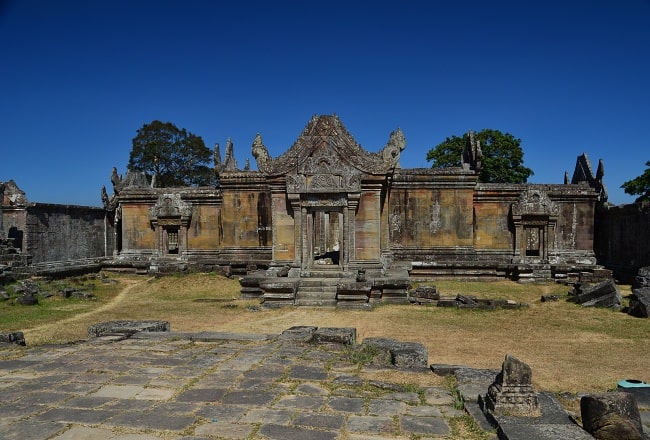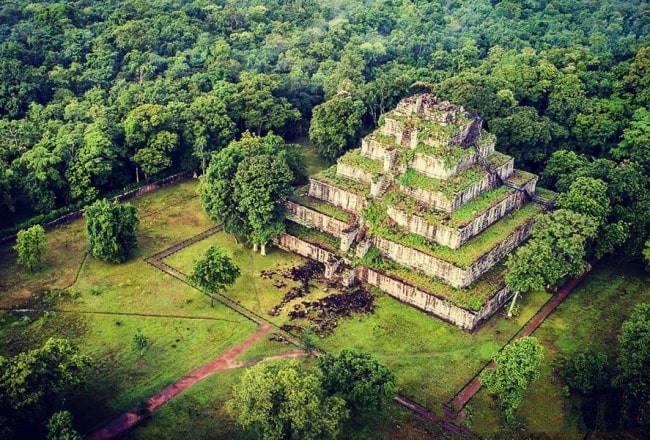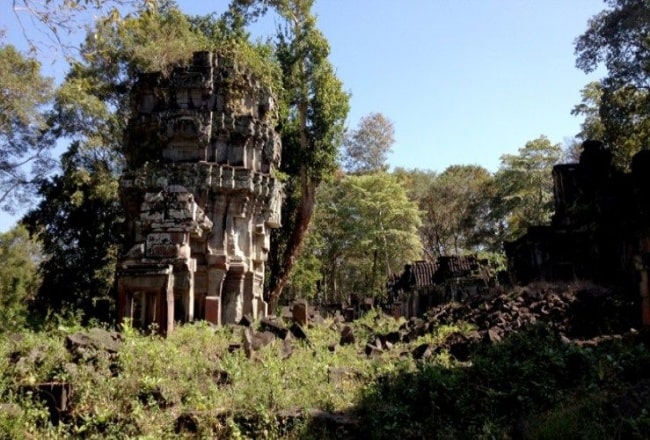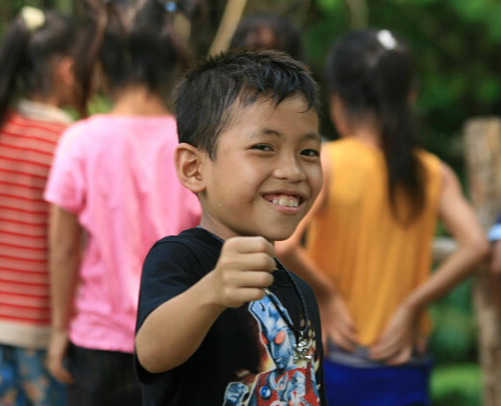Here are top things to see & do in Preah Vihear:
Noreay Temple
Noreay temple are located in Krala Peal Village, Pring Thom commune, Choam Ksan district, about 32 kilometers northeast of Preah Vihear provincial town. There are 3 temples stand separate from each other about 200 meters. The first site is surrounded by double rampart which is 100 meters long and 50 meters wide made of laterite.
It includes five temples made of sandstone, laterite and brick. The second site was completely damaged only temple base remain. The third site house Preah Noreay, but the temple was seriously damaged only Preah Noreay statue remain.According to the study, Noreay temple were built at the same time with Sambo Preykuk temple in 7th century. The temples are recently completely covered by forest.
Preah Vihear Temple

The World Heritage Committee, meeting for its 32nd session, finished inscribing the Temple of Preah Vihear sites on UNESCO?s World Heritage List on 8 July with the addition of 19 cultural sites and eight natural sites to the List.
Preah Vihear Temple is located in a pleasant environment with an attractive countryside slightly east of the mid section of the Dongrek Mountains.It is perched on the edge of a giant cliff, about 625 meters above sea level in Preah Vihear Province, Northern part of Cambodia, 625km from the capital city of Phnom Penh. It is also situated close to the Cambodia-Thai border.The temple has four levels and four courtyards which comprise of five Gopuras ( entrance pavilions some times surmounted by tower )
Palace Building or Gopuras on the third level: This group of building was the King's residence when he came to pay homage to the mighty God , and the two wings were the shelters for the pilgrims. The main temple are used for the high-ranking supreme divinities, this mighty group of building is considered as the center of the whole temple complex.
The front stone stairway : this main passage is on the North side. The stairway is 8 meters wide and 78 meters long,. The fist flight has 162 steps. At the first landing is a large stone singa statue on stone block. Another 54 flight of steps 4 meters wide and 27 meters long leads up to the second landing also decorated with stone signa statue.
The Nagaraj Courtyard : this stone-paved is 7 meters wide by 31.8 meters long. From here the stairway leads up to the first-level Gropura. The Stairheads are in the form of seven-headed snakes called "Ngu Suang " facing North towards the Prasat. The heads and tails of nagas on both sides look like ordinary snakes, characterizing and early example of this type of animal figures. The head portion of the naga on the west side looks very impressive because it is made from a single solid stone. The first level Gopura : this is a pavilion in Greek architecture style with cross plan on an elevated, rebates angle base on each of the roof doorway . Stone lions are placed on each of the roofs dooeway.
The temple can be reached by crossing the Cambodia-Thai gateway border from the Ubon Ratchantani Province of Thailand. Currently the visits are from 8.00 till 16.00 hours. For all the grandeur of its site, perched on the edge of a giant cliff and with a commanding view over northern Cambodia, Preah Vihear is difficult to visualize as a whole. The experience is truly a memorable one the series of ascents over the best part of a kilometer, the ornate Gopuras and the wealth of decorative detail truly staggers one's imagination.
Koh Ker Temple

Koh Ker was once an ancient capital of Cambodia, located in Srayong Cheung village, Srayong commune, Kulen district, about 49 kilometers west of the provincial town. The Koh Ker complex is on the Chhork Koki highland. It was built by King Jayavaraman IV (AD 928-942). Koh Ker temple is 35 meters high, and its design resembles a seven-stepped stupa. The temple faces west toward Angkor city. It was built to worship Treypuvanesvara, the god of happiness.
So far, 96 temples have been found in Koh Ker: Dav, Rumlum Bey, Beung Veng, Trapiang Prey, Dey Chhnang, Srok Srolao, Lingam, Kuk Srakum, Trapiang Ta, Sophy, Krahom, Andoung, Ang Khna, Teuk Krahom, Damrei Sar, Krarab, Banteay Pichoan, Kuk, Kmao, Thneung, Thorn Balang, Rohal, Chamneh, Sampich, Trapiang Svay, Neang Kmao, Pram, Bat, Khnar Chen, Klum, Chrab, Dangtung, Prang, Kampiang.... These temples were not constructed near each other. Today, many of them are no longer standing, and some are buried in the ground.
Bakan or Preah Khan Kampong Svay Temple

The Bakan temples are located in Ta Siang village, Ronakse commune, Sangkum Thmei district, about 105 kilometers southwest of the provincial town. on a plain that was a former worship place of the king. The temple is surrounded by two ramparts-inside and outside rampart. Inside each rampart, there are many other temples such as Neang Peou and Dangkao Baodos temples.The temple was likely a royal palace and worship place. According to historians, the site used to be a hiding place of King Jayavarman VII before he ascended to the throne in AD 1181 because the style of some construction is similar to the style of Bayon and Ta Prohm temples.
Outside the rampart, there are many other temples such as Preah Damrei, Preah Thkaol, Ta Prohm, Muk Buon and Preah Stung temples.Looking through into the large area beyond the wall of Prasat Bakan (Bakan Temple) in Preah Vihear province, laterite stone refracts the bright sunshine, enveloping the temple in a heavenly light. The towers of the temple have long since collapsed and the hundreds of pieces of stone which once made up Bakan are now a less-than-glorious pile of rubble. Even in this sad state destroyed in part by war, and in part by greed the fallen Bakan can still provide us with evidence of the once important place this temple held in the history of the Angkor period, but looters have other plans. In 2003 after a botched robbery, the central area collapsed and apsara and Buddha statues were stolen.
Wat Peung Preah Kor
Wat Peung Preah Kor is worship place located in Mohapol Village, Chhean Muk commune, Tbeng Meanchey district, next to the foot of Tbeng mountain. The site features beautiful natures and is a good place for local and foreign visitors to relax. Superstitious people believe that the site is very powerful.
Krapum Chhouk Temple
Krapum Chhouk Temple is located in Romdos commune, Rovieng district, about 45 kilometers south of the provincial town. The laterite and sanstone temple was built in the late 10th century to worship Brahmanism.
Neak Buos Temple
Neak Buos Temple is located in Choam Ksan district, about 75 kilometers north of Tbiang Meancheay provincial town. The laterite, sanstone and brick temple is 50 meters square and built on a plain to worship Brahmanism. It is very difficult to reach the temple because of bad road condition.
Kork Beng Temple

Kork Beng Temple is located in Wat Prasat Chey Preuk on Kork Beng Village, Kampong Pranak commune, Tbiang Meanchey district. The leterite amd sandstone temple was built between AD 936 and 951 by a commander name Kork on ordered from King Jayavarman IV. There is a hug Beng Tree near the temple. Therefore, the king named the temple Kork Beng. Today only a few stones of the ancient temple remain. The temple, however, was reconstructed with concrete in 1988. The new temple is 8 meters high and 12 meters square. There is a statue of Bodhisattva in temple center, where the worship place is.
Phnom Pralean Temple
Phnom Pralean temple is on a 180 meters small hill located in Krang Dong village, Preah Kliang commune, Tbiang Meanchey district, about 25 kilometers from the provincial town. The laterite and sandstone temple, built to worship Brahmanism, is 160 meters long and 60 meters wide. Surrounding the temple is a beautiful nature and abundant fresh airs where a good place to visit is.
Foof of Phnom Tbeng Wat Bak Kam
Wat Bak Kam is located along Tbeng mountain foot in Bak Kam village, Chhien Muk commune, Tbeng Meanchey district, about 17 kilometers west of the provincial town. The pagoda is 1, 000 meters long and 400 meters wide. The site offers nice view, forest and fresh air year round. Local villagers usually visit this site during holidays or national festivals.
Beside the pagoda, there is a large rock called Thma Peung Angkam (Thma Peung means overhanging rock and Angkam mean chaff). According to the local people, in the past, because of the failure of war with neighboring country, the Khmer commander and his troops hide under that rock. They cultivated rice in a nearby field to support their living. They husked rice under that rock and left the chaff. Later, local villagers found a lot of chafff under the rock, which is why the place is call Thma Peung Angkam. The rock is alos believed to be an important worship site.






















